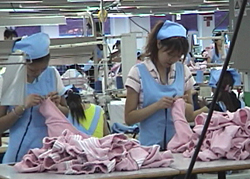

Jennifer McCord
Jennifer McCord is a senior fashion merchandising major at the University of Delaware, who is also studying social responsibility and sustainability in the fashion industry. She is in the University Honors Program, works as a Writing Fellow, and is active with the volunteer student organization Lori’s Hands.
McCord is currently working on a case study of Guatemalan denim apparel manufacturer Denimatrix for her senior honors thesis. She plans to graduate in May 2011.
As a fashion merchandising student who is interested in how the industry deals with corporate social responsibility (CSR), I have learned a fair bit about multi–stakeholder initiatives (MSIs) that aim to improve the social conditions of the apparel industry. In October 2010, I was lucky enough to tag along with Prof. Marsha Dickson to the Fair Labor Association (FLA) board meetings in Gaoming, China, to see firsthand an MSI in action. After an overwhelming five days that included a stakeholder forum on fair wages, FLA board meetings, and several tours of manufacturing facilities, I had a lot to think about. Here, I’ll share a couple of the lessons that stood out.
One of the most valuable takeaways from my trip to China was a new appreciation for the value of MSIs. The purpose of an MSI is to bring different groups, holding different priorities, together to create a more comprehensive discussion of, and ultimately solution for, a specific set of issues. In theory, of course, this sounds great, but I had been skeptical of how effectively this could play out in the real world. After my first day in China, however, I began to reconsider–the discussions at the FLA meetings seemed to bring about some significant progress, especially around the area of purchasing practices.

The interaction between buyers and suppliers can be a touchy subject. Suppliers may be blamed for late, incorrect, or incomplete orders, and buyers are often accused of making unreasonable demands while paying rock-bottom prices. While I am familiar with both sides of this argument, as a merchandising student I am more often required to assume the mindset of the buyer; most of my exposure to the reality of suppliers has been less frequent, more distant, and limited to issues faced by the workers rather than the factory owners.
In China, however, I heard about the issues faced by suppliers and calls for change from the suppliers themselves. Not only did I hear these suppliers’ voices, but more importantly, so did the brand representatives who were in attendance (in some cases, brands that sourced from those suppliers). Brands were able to hear about the conditions in the countries they source from and the struggles suppliers face, some of which are caused by the brands’ purchasing practices, from the people who are handling those issues every day. Furthermore, these issues were raised in a forum that allowed both sides to have a conversation, understand each other’s pressures and responsibilities, and build a relationship. In this respect, the FLA works tremendously well at facilitating communication, removing the “big bad brand” and “victimized supplier” stereotypes, and humanizing the relationship.
NGOs and universities also were represented at the FLA meetings and brought even more voices and perspectives to the table. While the many differing opinions certainly made for longer discussions, they also made for more thorough ones. This translates directly to the FLA’s conclusions and programs; while it may take longer to hear everyone out, make decisions, and find a mutually agreeable compromise, the end result is more comprehensive and practical than if any single group attempted to achieve a solution on its own.
Perhaps the most surprising part of the whole trip was how unsurprised I was at the topics covered in these conversations. While complex, they were not unfamiliar. Many of the issues at the table were ideas about which I have read, researched, and written for courses in the Certificate in Socially Responsible and Sustainable Apparel Business, and my understanding of those issues has certainly been enhanced by the perspectives and business realities I’ve learned from the fashion merchandising curriculum. Not only is this a testament to how thoroughly I’ve been prepared for the industry, but it’s also an enormous reassurance as I stand on the terrifying brink of “the real world.” Having seen the real world at work, I am now much more aware of my own capabilities and what exactly I am getting myself into.

I realized, though, that it wasn’t just that I had information from both the fashion merchandising and certificate curricula; it was how those types of knowledge worked together. My familiarity with the CSR material helped me to keep up, but the fashion merchandising lens through which I saw it was what helped me stay grounded. This realization taught me an important lesson for the future: Always have a perspective. Given the recent surge in interest in CSR and sustainability, this lesson is more important than ever. Being ethically focused is not enough now that it is becoming a reality of everyone’s job; it is essential to bring something practical and specific to the table too. It could be a sourcing perspective, a manufacturing perspective, a buying perspective, or something else, but we have to make ourselves valuable beyond knowledge of CSR and be great at our “day jobs” too.
This ties in nicely with sustainability. Even if your company is doing outstanding work on the environmental and social sides, you still have to be good at the economic side of the business to sustain the company and continue to provide those environmental and social benefits. CSR is only an asset if everything else works too.
Having a practical lens or perspective is valuable not only to the business side, however. It also contributes significantly to the CSR side, as evidenced by the conversations I heard in China. The FLA discussions wouldn’t have been half as complex and wouldn’t have gotten anywhere practical if individuals involved did not have distinct angles and deep practical experience. Just as having different perspectives on the social issues at hand brought more comprehensive discussions, so too did the different angles on business. Fortunately, given the broad range of our undergraduate curriculum, all the seniors graduating from the fashion merchandising curriculum should feel reassured that they are prepared for both.